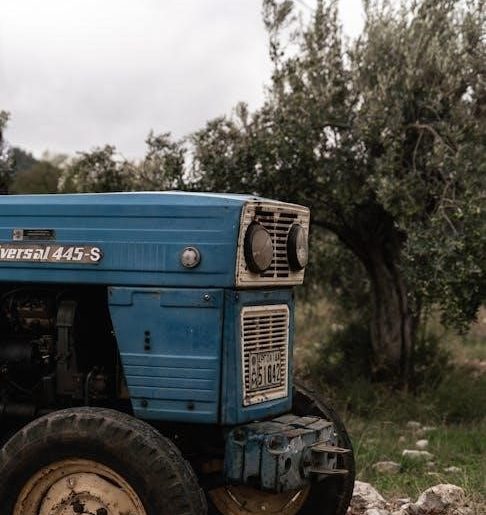Rust-Oleum Farm and Implement Paint is a durable‚ rust-preventative enamel designed for agricultural equipment․ It offers superior protection and color retention for tractors‚ trailers‚ and machinery․
1․1 Overview of Rust-Oleum Farm and Implement Paint
Rust-Oleum Farm and Implement Paint is a high-quality‚ rust-preventative enamel designed specifically for agricultural equipment and machinery․ It provides durable protection against rust and corrosion‚ ensuring long-lasting performance․ Available in original equipment colors‚ this paint is ideal for tractors‚ trailers‚ lawn mowers‚ and other farm implements․ It offers excellent coverage‚ chip resistance‚ and color retention‚ making it a reliable choice for maintaining equipment appearance and functionality․ The paint is formulated to adhere well to metal surfaces and withstand harsh outdoor conditions‚ including fading and chipping․ Its superior protection and versatility make it a popular choice for farmers and equipment owners seeking to preserve their investments․
1․2 Importance of Using Durable Paint for Farm Equipment
Using durable paint for farm equipment is essential to protect it from harsh environmental conditions‚ such as moisture‚ UV exposure‚ and physical wear․ Farm equipment often operates in demanding settings‚ where rust and corrosion can quickly degrade metal surfaces‚ leading to costly repairs and downtime․ Durable paint acts as a protective barrier‚ preventing rust formation and extending the lifespan of machinery․ It also reduces the need for frequent touch-ups‚ saving time and resources․ Additionally‚ high-quality paint enhances the appearance of equipment‚ maintaining its value and professionalism․ Investing in durable paint ensures equipment remains functional‚ efficient‚ and visually appealing for years․
1․3 Key Features of Rust-Oleum Farm and Implement Paint
Rust-Oleum Farm and Implement Paint is renowned for its exceptional durability and protective qualities․ It offers superior resistance to rust‚ corrosion‚ and weathering‚ making it ideal for outdoor farm equipment exposed to harsh conditions․ The paint adheres well to metal surfaces‚ ensuring a long-lasting finish․ It is available in a variety of colors to suit different equipment and aesthetic preferences․ The paint is also formulated to withstand heavy use and abrasion‚ reducing the need for frequent repairs․ Additionally‚ it dries quickly‚ allowing equipment to return to service promptly․ Its UV-resistant finish helps maintain color vibrancy over time‚ ensuring a professional appearance for farm machinery․
Surface Preparation for Painting
Proper surface preparation ensures strong paint adhesion and durability․ Clean the surface thoroughly‚ remove rust and corrosion‚ and sand for smoothness before painting begins․
2․1 Cleaning the Surface
Cleaning the surface is the first step in preparing for painting with Rust-Oleum Farm and Implement Paint․ Start by removing any dirt‚ grime‚ or grease using a solvent like mineral spirits or acetone․ This ensures a clean base for the paint to adhere to․ For tougher grease and oil residue‚ consider using a degreaser‚ following the product’s instructions carefully․ After cleaning‚ use a wire brush or sandpaper to remove any loose rust and smooth out the surface․ This step is crucial for preventing future rust and ensuring proper paint adhesion․ Finally‚ wipe down the surface with a clean cloth or compressed air to remove any remaining dust or debris․ Proper cleaning sets the foundation for a durable and long-lasting paint job․
2․2 Sanding and Smoothing the Surface
Sanding and smoothing the surface is essential for achieving a professional finish with Rust-Oleum Farm and Implement Paint․ Begin with medium-grit sandpaper (120-150 grit) to remove small imperfections‚ such as minor rust spots or rough patches․ Work in small‚ circular motions‚ ensuring even coverage․ For smoother results‚ progress to finer grit sandpaper (220-240 grit) to polish the surface․ Sanding creates a surface profile that enhances paint adhesion and durability․ After sanding‚ use a clean cloth or compressed air to remove dust and debris․ A smooth‚ well-prepared surface ensures better paint coverage and a longer-lasting finish‚ making this step critical for optimal results․
2․3 Removing Rust and Corrosion
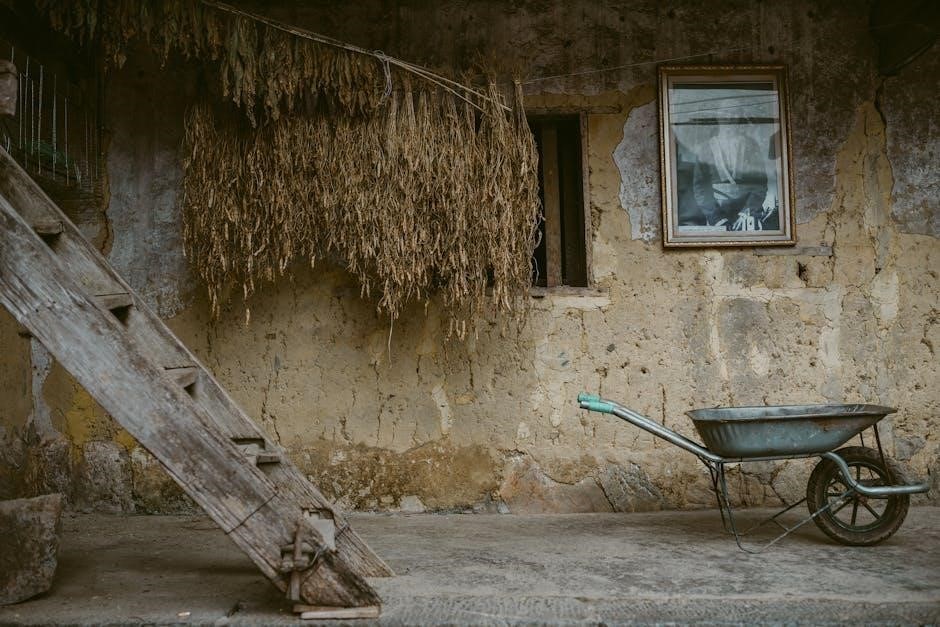
Removing rust and corrosion is crucial before applying Rust-Oleum Farm and Implement Paint to ensure proper adhesion and prevent further damage․ Start by scraping off loose rust using a wire brush or sandpaper․ For severe rust‚ use a rust remover or a mixture of vinegar and water to dissolve corrosion․ Rinse thoroughly with clean water and let the surface dry․ If rust has penetrated deeply‚ consider replacing the affected metal․ For minor spots‚ sanding or grinding can smooth the area․ Removing rust ensures a strong bond between the metal and paint‚ enhancing durability and protecting the equipment from further deterioration․
2․4 Repairing Damaged or Rusted Metal
Before painting‚ repair any damaged or rusted metal to ensure a smooth‚ durable finish․ Assess the damage and clean the area thoroughly․ For small holes or gaps‚ use a metal filler or patching compound‚ following the manufacturer’s instructions․ Allow the filler to dry completely before sanding it smooth with medium-grit sandpaper․ For larger repairs‚ welding may be necessary to restore structural integrity․ Once repaired‚ sand the entire area to ensure evenness and remove any sharp edges․ Prime the repaired section with a rust-inhibiting primer before applying Rust-Oleum Farm and Implement Paint․ Proper repairs ensure a strong‚ long-lasting bond between the metal and paint‚ preventing further deterioration․
2․5 Priming the Surface for Better Adhesion
Priming the surface is essential for ensuring better adhesion and durability of Rust-Oleum Farm and Implement Paint․ A high-quality primer creates a strong bond between the metal and paint‚ preventing peeling and flaking․ Apply a rust-inhibiting primer to bare metal or previously painted surfaces‚ following the manufacturer’s instructions․ Use a brush‚ roller‚ or spray gun for even coverage․ Allow the primer to dry completely‚ typically 24 hours‚ before painting․ This step is crucial for maintaining the paint’s protective properties and ensuring long-term performance․ Proper priming helps prevent rust from forming and extends the lifespan of your farm equipment’s finish․
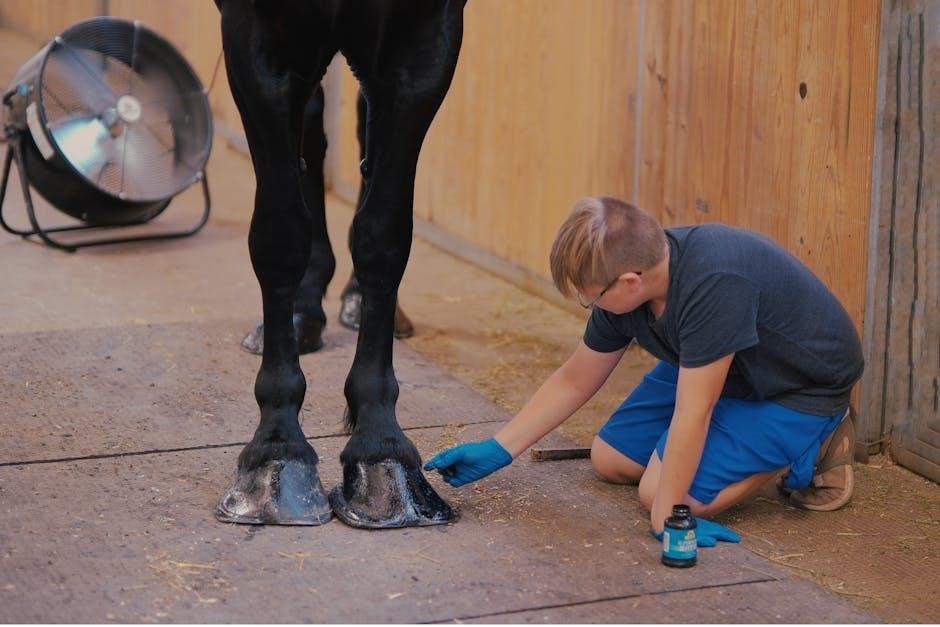
Application Methods for Rust-Oleum Paint
Rust-Oleum Farm and Implement Paint can be applied using various methods such as brushing‚ spraying‚ rolling‚ or touch-up techniques․ Each method requires specific tools and techniques for optimal results․
3․1 Brush Painting: Tools and Techniques
Brush painting is a popular method for applying Rust-Oleum Farm and Implement Paint‚ offering precision and control․ Use high-quality natural bristle brushes for oil-based paints․ Choose brush sizes based on the surface area‚ with smaller brushes for detailed work and larger ones for broad coverage․ Dip the brush about 1-2 inches into the paint‚ and wipe excess on the rim to avoid drips․ Apply thin‚ even strokes in one direction‚ working in small sections to prevent paint from drying too quickly․ Maintain steady pressure for uniform coverage․ Allow the first coat to dry completely before applying a second coat․ This method is ideal for intricate or hard-to-reach areas on farm equipment․ Always work in a well-ventilated area and follow safety guidelines․
3․2 Spray Painting: Equipment and Safety Tips
Spray painting with Rust-Oleum Farm and Implement Paint requires proper equipment and safety measures for optimal results․ Use a high-volume‚ low-pressure (HVLP) sprayer or an airless sprayer for smooth‚ even coverage․ Always wear a mask with a filter‚ safety glasses‚ and gloves to protect against paint overspray and fumes․ Work in a well-ventilated area‚ away from open flames or sparks․ Shake the paint can thoroughly before pouring into the sprayer․ Maintain a consistent distance of 8-12 inches from the surface and move the sprayer steadily to avoid drips․ Avoid spraying in direct sunlight or windy conditions‚ as this can lead to uneven drying․ Follow Rust-Oleum’s recommendations for nozzle sizes and pressure settings․ Clean equipment immediately after use with mineral spirits․ Safety and proper technique ensure professional-looking results and prolong equipment lifespan․
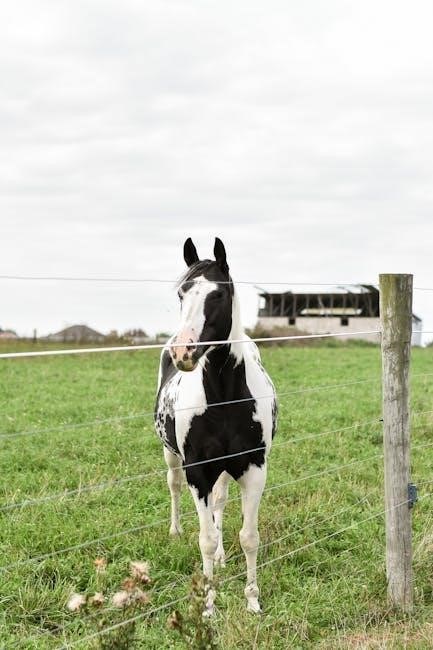
3․3 Rolling: Efficient Coverage for Large Areas
Rolling is an efficient method for applying Rust-Oleum Farm and Implement Paint to large‚ flat surfaces․ Use a high-quality roller with an extension pole to cover vast areas quickly․ Choose rollers with dense foam covers for smooth finishes․ Work in sections‚ applying even pressure to avoid streaks․ Overlap strokes slightly to ensure complete coverage․ For best results‚ roll in one direction only to maintain uniformity․ Avoid excessive paint buildup by not overloading the roller․ This method is ideal for barns‚ silos‚ or large equipment‚ saving time compared to brushing․ Always work in well-ventilated areas and follow Rust-Oleum’s recommendations for roller nap lengths and painting conditions․
3․4 Touch-Up Painting for Small Areas
For small‚ damaged areas‚ touch-up painting with Rust-Oleum Farm and Implement Paint is a quick and effective solution․ Start by cleaning the area thoroughly with a wire brush or sandpaper to remove dirt‚ rust‚ or flaking paint․ Feather the edges of the damaged area to blend it with the surrounding surface․ Apply the paint using a small brush‚ focusing on the damaged spot to avoid spreading paint unnecessarily․ Work in thin layers‚ allowing each coat to dry before applying the next․ This method ensures precise coverage and maintains the protective qualities of the paint․ Regular touch-ups prevent further damage and extend the lifespan of your equipment․
Drying and Curing Process
Drying and curing are critical for durability and protection․ Initial drying occurs within 24 hours‚ but full curing takes up to 7 days‚ depending on conditions․ Ensure surfaces remain dry during curing to avoid damage and promote hardening․
4․1 Drying Time: Factors Affecting Paint Drying
The drying time of Rust-Oleum Farm and Implement Paint depends on environmental conditions․ Temperature‚ humidity‚ and air circulation significantly impact drying speed․ Ideal conditions include temperatures between 50°F and 90°F (10°C to 32°C) and low humidity․ Higher temperatures accelerate drying‚ while cooler conditions slow it down․ Ensure good air circulation to prevent moisture trapping‚ which can delay drying․ The surface condition also plays a role; clean‚ dry surfaces promote faster drying․ Thin‚ even coats dry quicker than thick layers․ Avoid painting in direct sunlight or during wet weather to ensure proper drying and adhesion․ Always follow recommended application guidelines for optimal results․
4․2 Curing Process: Ensuring Longevity of Paint
The curing process for Rust-Oleum Farm and Implement Paint is critical for achieving maximum durability․ Allow the paint to cure in a well-ventilated area‚ away from direct sunlight and moisture․ The curing time depends on environmental conditions‚ typically ranging from 24 to 48 hours․ Higher temperatures and low humidity accelerate curing‚ while cooler conditions slow it down․ Avoid exposing the painted surface to water or chemicals during this period․ Light use can begin after curing‚ but full hardness and resistance may take up to 7 days․ Proper curing ensures the paint adheres well and resists wear‚ making it essential for long-term protection of farm equipment․
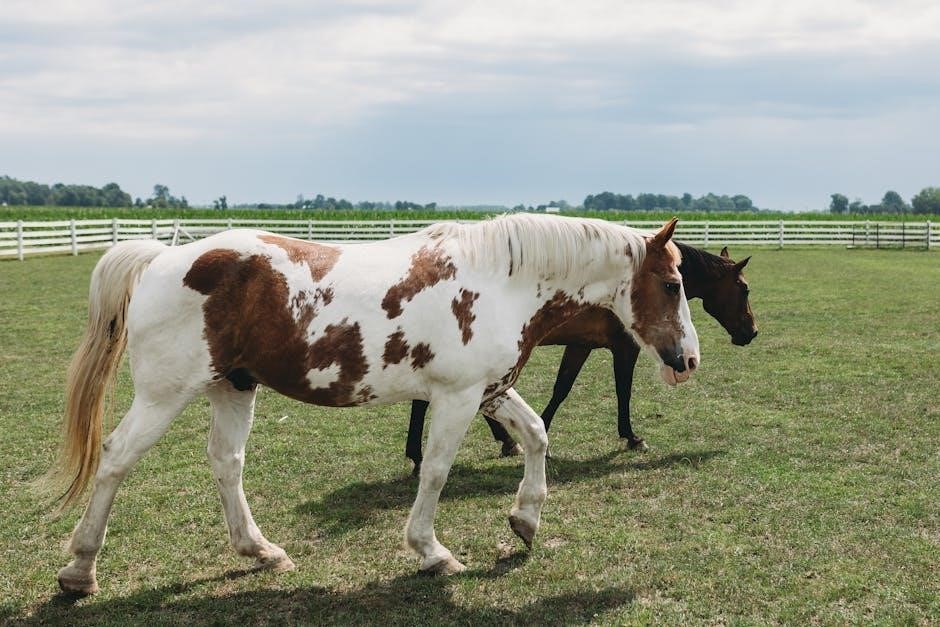
4․3 Avoiding Exposure to Water During Curing
Exposure to water during the curing process can significantly compromise the paint’s durability and adhesion․ Moisture interferes with the chemical bonding of the paint to the metal surface‚ leading to a weaker finish․ To prevent this‚ ensure the painted equipment is kept in a dry‚ sheltered area․ If rain or humidity is expected‚ cover the equipment with a waterproof tarp or move it indoors․ Avoid washing or rinsing the surface during the curing period․ Even high humidity can slow down the curing process and affect the paint’s performance․ Proper protection from water ensures the paint cures evenly‚ maintaining its protective and aesthetic qualities for farm equipment․
Maintenance and Touch-Ups
Regular maintenance extends the lifespan of Rust-Oleum paint․ Inspect surfaces for wear‚ address scratches promptly‚ and reapply paint as needed․ Protect equipment from harsh weather and chemicals to preserve the finish․
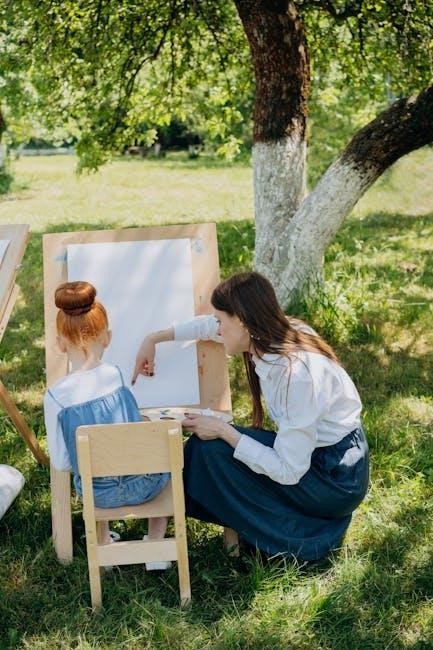
5;1 Regular Inspection of Painted Surfaces
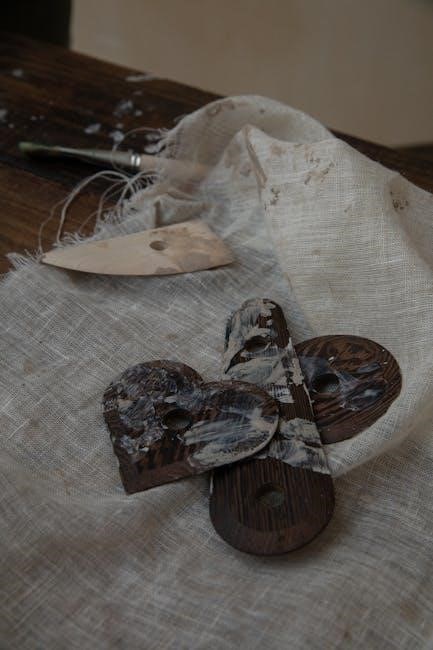
Regular inspection of painted surfaces is crucial to ensure the longevity of Rust-Oleum Farm and Implement Paint; Start by visually examining the equipment for signs of wear‚ such as chipping‚ fading‚ or rust․ Use a gloved hand to feel for rough spots or peeling paint․ Pay particular attention to areas exposed to heavy use or harsh weather conditions․ Check for any damage caused by chemicals‚ abrasion‚ or moisture․ Inspections should occur at least twice a year‚ or more frequently if the equipment is used in demanding environments․ Early detection of issues allows for prompt touch-ups‚ preventing further deterioration and protecting the metal from corrosion․ This routine maintenance ensures the paint remains effective and the equipment stays in optimal condition․
5․2 Touch-Up Techniques for Minor Damages
For minor damages to painted surfaces‚ such as small scratches or chips‚ prompt touch-ups are essential to prevent rust and further deterioration․ Begin by cleaning the damaged area with a wire brush or sandpaper to remove dirt and loose paint․ Lightly sand the surface to smooth the edges of the damaged area․ Apply a small amount of Rust-Oleum Farm and Implement Paint using a fine brush‚ feathering the edges to blend with the surrounding paint․ Allow the paint to dry completely according to the product instructions․ Regular touch-ups maintain the protective barrier and preserve the appearance of the equipment․ Always wear gloves and work in a well-ventilated area to ensure safety․
5․3 Protecting Paint from Environmental Factors
Protecting Rust-Oleum Farm and Implement Paint from environmental factors like UV rays‚ moisture‚ and extreme temperatures is crucial for maintaining its durability․ Regularly inspect painted surfaces for signs of wear or damage caused by exposure to the elements․ To shield the paint‚ apply a clear coat or sealant to repel water and reduce UV-induced fading․ Avoid exposing freshly painted equipment to direct sunlight or heavy rain until the paint is fully cured․ Store equipment in a dry‚ shaded area when not in use to minimize weathering․ Clean surfaces regularly to remove dirt and contaminants that may degrade the paint over time․ By taking these steps‚ you can ensure the paint remains protective and visually appealing for years․
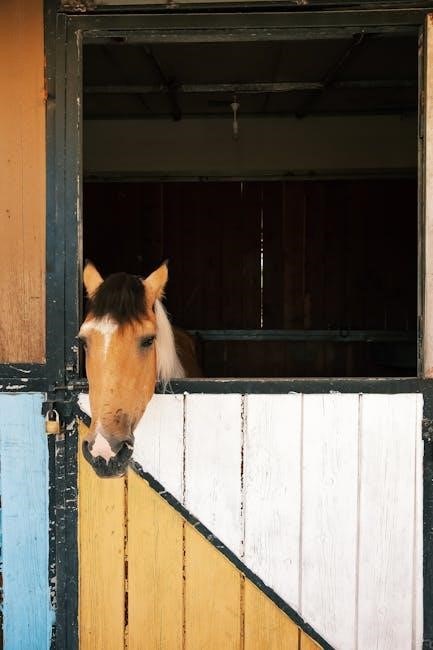
Safety Precautions and Best Practices
Always wear protective gear‚ including masks‚ gloves‚ and eyewear‚ when handling Rust-Oleum paint․ Ensure good ventilation to avoid inhaling fumes․ Follow proper disposal methods for leftover paint and materials to minimize environmental impact․ Keep paint away from open flames or sparks․ Avoid skin contact and wash hands thoroughly after use․ Refer to the safety data sheet for specific precautions․ Proper safety practices ensure a safe and successful painting experience while protecting health and the environment․
6․1 Handling Paint and Solvents Safely
When working with Rust-Oleum Farm and Implement Paint‚ always handle the paint and solvents with care to ensure safety․ Wear appropriate gloves and goggles to prevent skin and eye irritation․ Work in a well-ventilated area to avoid inhaling fumes․ Keep paint and solvents away from heat sources‚ sparks‚ or open flames‚ as they are flammable․ Store products in their original containers‚ tightly sealed‚ and out of reach of children and pets․ Dispose of rags and materials used for cleaning according to local regulations․ Never mix solvents or paint with other chemicals unless instructed by the manufacturer․ Keep a fire extinguisher nearby and have a spill kit available in case of accidents․ Proper handling ensures a safe and efficient painting process․
6․2 Protective Gear: Masks‚ Gloves‚ and Eyewear
Wearing the right protective gear is essential when using Rust-Oleum Farm and Implement Paint to ensure safety and prevent potential hazards․ A mask or respirator is crucial to avoid inhaling paint fumes or dust particles․ Choose a mask with a filter designed for organic vapors to maximize protection․ Gloves‚ preferably made of durable‚ chemical-resistant materials like nitrile or rubber‚ protect your hands from paint and solvents․ Eyewear‚ such as goggles or safety glasses with a splash guard‚ shields your eyes from paint splatters or debris․ Always inspect protective gear for damage before use and replace it as needed․ Wearing the correct protective equipment helps prevent accidents and ensures a safe painting experience․
6․3 Disposal of Paint and Materials
Proper disposal of Rust-Oleum Farm and Implement Paint and materials is crucial to protect the environment and comply with local regulations․ Allow leftover paint to harden by mixing it with cat litter or sand before disposal․ Empty paint cans can be disposed of with the lid removed to show they are empty․ Cleaning tools and rags should be washed with mineral spirits or paint thinner‚ then disposed of according to local guidelines․ Do not pour paint or solvents down drains or storm sewers‚ as this can contaminate water systems․ Check with your local waste management for hazardous waste collection days or facilities․ Always follow environmental regulations to ensure safe and responsible disposal practices․
6․4 Avoiding Lead Paint Dust Risks
When working with Rust-Oleum Farm and Implement Paint‚ minimize exposure to potential lead paint dust‚ especially if repainting older equipment․ Wear a disposable coverall‚ HEPA-filter mask‚ and protective eyewear․ Dampen surfaces with water before sanding to reduce dust․ Use a HEPA vacuum for cleanup and avoid dry sweeping․ Contain work areas with plastic sheeting to prevent dust spread․ Shower and launder clothes immediately after work․ Dispose of materials like sanding debris and disposable gear in sealed containers; Keep children and pets away from work areas․ Follow EPA guidelines for lead-safe practices to ensure safety and environmental compliance․

Troubleshooting Common Issues
Address peeling by re-sanding and reapplying paint․ Fading may result from UV exposure; apply a clear coat․ Streaks can be fixed by re-spraying evenly․
7․1 Peeling or Flaking Paint: Causes and Solutions
Peeling or flaking paint on farm equipment is often caused by inadequate surface preparation‚ such as poor cleaning or insufficient sanding․ Moisture trapped beneath the paint can also lead to premature peeling․ To address this‚ ensure the surface is clean‚ dry‚ and free of rust before painting․ Lightly sand the affected area‚ feathering the edges to blend with the surrounding paint․ Apply a fresh coat of Rust-Oleum Farm and Implement Paint‚ following the recommended drying time․ Avoid painting in direct sunlight or high humidity‚ as this can hinder proper adhesion․ Regular maintenance and touch-ups can prevent further peeling and extend the paint’s durability․
7․2 Fading or Discoloration of Paint
Fading or discoloration of Rust-Oleum Farm and Implement Paint can occur due to prolonged exposure to sunlight‚ harsh weather conditions‚ or chemical interactions․ UV rays break down pigments‚ leading to a dull finish․ To prevent this‚ apply a clear coat with UV protection after painting․ Regular touch-ups and maintaining a clean surface can help preserve color vibrancy․ Store equipment in shaded areas when possible to minimize sun exposure․ Ensure proper paint application‚ including adequate drying time‚ to maintain color consistency․ Address discoloration promptly by lightly sanding and recoating affected areas․ Using high-quality paint specifically designed for outdoor use‚ like Rust-Oleum‚ enhances color retention and durability over time․
7․3 Streaks or Uneven Finish: How to Fix
Streaks or uneven finishes in Rust-Oleum Farm and Implement Paint can result from improper application techniques‚ such as using the wrong brush or applying too much paint․ To fix this‚ lightly sand the affected area with fine-grit sandpaper (e․g․‚ 320-grit) to smooth the surface․ Remove dust with a clean cloth or compressed air․ Apply a new coat‚ ensuring even coverage with slow‚ steady brush strokes in the same direction․ Avoid overloading the brush with paint‚ as this can lead to drips and streaks․ For spray applications‚ maintain a consistent distance and overlap patterns․ Proper preparation and technique will help achieve a professional-looking finish․ Regular practice improves results‚ ensuring a smooth‚ even appearance․
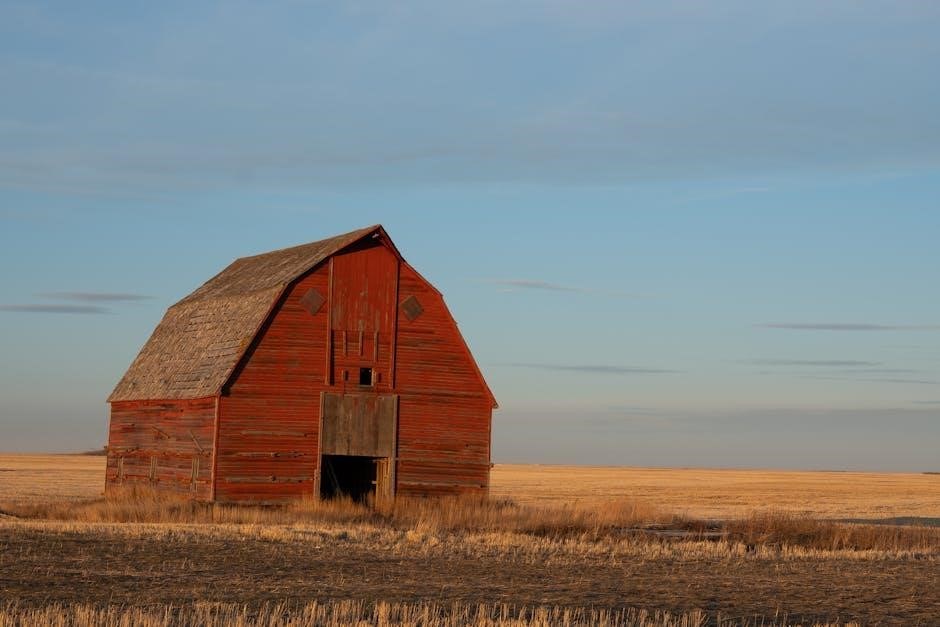
Additional Tips and Considerations
Always mix paint thoroughly before application․ Use hardeners for added durability․ Apply clear coats for gloss retention․ Store paint in a cool‚ dry place․ Use proper tools for smooth results․ Ensure optimal conditions for painting․ Follow manufacturer guidelines for best outcomes․ Regular maintenance ensures long-lasting finish․ Proper ventilation enhances drying and curing․ Avoid painting in direct sunlight or high humidity․ Keep paint away from children and pets․ Dispose of leftover paint responsibly․ Clean tools immediately after use․ Test paint on a small area first․ Document painting process for future reference․ Maintain records of paint usage and application dates․ Use rust-inhibitive primers for metal surfaces․ Avoid painting over existing layers without proper preparation․ Consider environmental factors like UV exposure and weathering․ Use high-quality brushes or sprayers for professional finishes․ Avoid over-thinning paint‚ as it may weaken adhesion․ Apply thin‚ even coats for better coverage․ Allow proper drying time between coats․ Inspect equipment regularly for wear and tear․ Address minor damage promptly to prevent rust․ Use compatible paint products for best results․ Keep emergency contact information handy․ Follow safety guidelines strictly․ Dispose of rags properly to prevent fires․ Use drop cloths to protect surrounding areas․ Clean up spills immediately․ Stay organized to avoid waste․ Plan projects during optimal weather conditions․ Use timers for drying intervals․ Keep a well-ventilated workspace․ Maintain tools in good condition․ Learn from past painting experiences․ Share tips with others for collaborative improvement․ Document lessons learned for future projects․ Stay updated on new painting techniques and products․ Participate in workshops or online forums for knowledge sharing․ Use technology‚ like paint calculators‚ for accurate measurements; Invest in quality equipment for long-term savings․ Prioritize safety above all else․ Be patient and meticulous for professional-looking results․ Celebrate successful projects to stay motivated․ Continuously improve painting skills through practice․ Explore creative ways to repurpose leftover materials․ Support sustainable painting practices when possible․ Contribute to a community of painters for shared growth․ Embrace challenges as opportunities to learn․ Stay positive and enjoy the process of creating durable‚ protective finishes․
8․1 Mixing Paint: Ratio and Thinning
Always mix Rust-Oleum Farm and Implement Paint according to the manufacturer’s instructions․ The recommended ratio is typically 1 part hardener to 4 parts paint․ Use a stir stick to ensure thorough mixing‚ as this prevents streaks and ensures proper adhesion․ For thinning‚ use a high-quality solvent like mineral spirits‚ but avoid over-thinning‚ as it may weaken the paint’s durability․ Start with small amounts of solvent and test the consistency․ Never mix more paint than needed for the project to avoid waste․ Allow the mixture to sit for a few minutes before application․ Proper mixing and thinning ensure a smooth‚ even finish and long-lasting protection for your equipment․
8․2 Using Hardeners for Enhanced Durability
Using a hardener with Rust-Oleum Farm and Implement Paint significantly enhances durability and resistance to wear․ Hardeners work by creating a stronger cross-linking bond in the paint film‚ resulting in a tougher finish․ Always mix the hardener according to the manufacturer’s instructions‚ typically at a ratio of 1 part hardener to 4 parts paint․ Precise measurement is crucial to avoid weakening the paint․ Hardeners are especially beneficial for equipment exposed to heavy use or harsh environmental conditions․ They improve resistance to chipping‚ cracking‚ and fading․ For best results‚ mix small batches to ensure the hardener is evenly distributed․ This step ensures long-lasting protection for your farm equipment․
8․3 Applying Clear Coat for Gloss Retention
Applying a clear coat to Rust-Oleum Farm and Implement Paint helps preserve the gloss and protect the paint from fading․ It acts as a protective barrier against UV rays and environmental elements․ For optimal results‚ apply the clear coat 24 to 48 hours after the base coat‚ ensuring the paint is fully dry․ Use a high-quality brush or spray gun for even coverage․ Avoid over-application‚ as it may lead to yellowing or unevenness․ Thinning the clear coat slightly with solvent can improve flow and adhesion․ Regular inspections and touch-ups with clear coat will maintain the appearance and durability of your equipment․ This step ensures a professional finish and long-lasting gloss retention․
